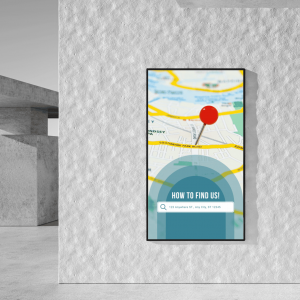
While local council digital signage has a range of applications, providing directions is easily the most popular use. And there’s good reason for this – digital signage is perfectly suited to helping visitors find their way.
Here we take a closer look at why councils are choosing to invest in digital directional signage. As part of this, we explore the main benefits of using local council digital signage to support wayfinding. We also share our advice on maximising the effectiveness of your digital directional signage.
Digital is more effective than traditional directional signage
The dynamic nature of local council digital signage helps it grab, and hold, the attention of visitors. It’s also more engaging, meaning viewers retain and can recall more of the displayed content. These are important factors for effective directional signage.
What’s more, local council digital signage can be set up to cycle automatically through multiple screens of content. This increases the amount of information provided, particularly when compared to traditional directional signage. It also means that a single sign can be used for multiple purposes – like wayfinding, community events promotion, and information sharing.
As changes can be made in a few clicks and updates are published in almost real-time, managing content is easy. To make this process even more straightforward, you can automate it by integrating your digital signage and facilities management systems. This is a great option when you have spaces that can be booked, like meeting rooms and sports facilities.
While a solution can be tailored to a wide variety of sites, digital directional signage is particularly effective for larger areas. For example, a digital screen placed in a natural public congregation point would be the perfect community directory. Visitors can see maps, search for specific locations, and even research information on local attractions and events.
Digital directional signage supports self-service and interactivity
Digital displays can go a step further than traditional directional signage, allowing viewers to shape the content they are presented. Whether this is by searching, zooming and scrolling, or targeting exact locations, it makes wayfinding much easier. It can also help reduce the need for the strong spatial awareness required to interpret most traditional maps.
Digital directional signage systems can also be designed to support visitor management, further reducing the stress on your reception team. Connecting your signage system to your staff directory will allow visitors to search for the person they want to see.
Local council digital signage can also support visitors looking for details of specific services or policies. A simple search function can be set up to scan your council’s knowledge base and provide the information they need. You can also use this enquiry data to identify frequently asked questions and plan future council communications.
Digital signs make emergency management easier
Digital directional signage can be invaluable in an emergency situation, allowing almost immediate publication of updates. For example, they can be used to support evacuation announcements, providing details of exit procedures and assembly points. They can also help keep people updated during an active emergency, providing details of the specific risk and safety precautions.
Critically, your signage content can be updated quickly and regularly, with information rolled out across all digital screens concurrently. This helps keep your staff and visitors safe and reduces the risk of announcements being missed. It also helps make sure that the safety advice being provided is consistent across the whole site.
Want more information?
If you’d like to discuss what digital directional signage could do for your organisation, give Amped Digital a call. We are local council digital signage experts and can tailor a system to your exact needs and budget.










